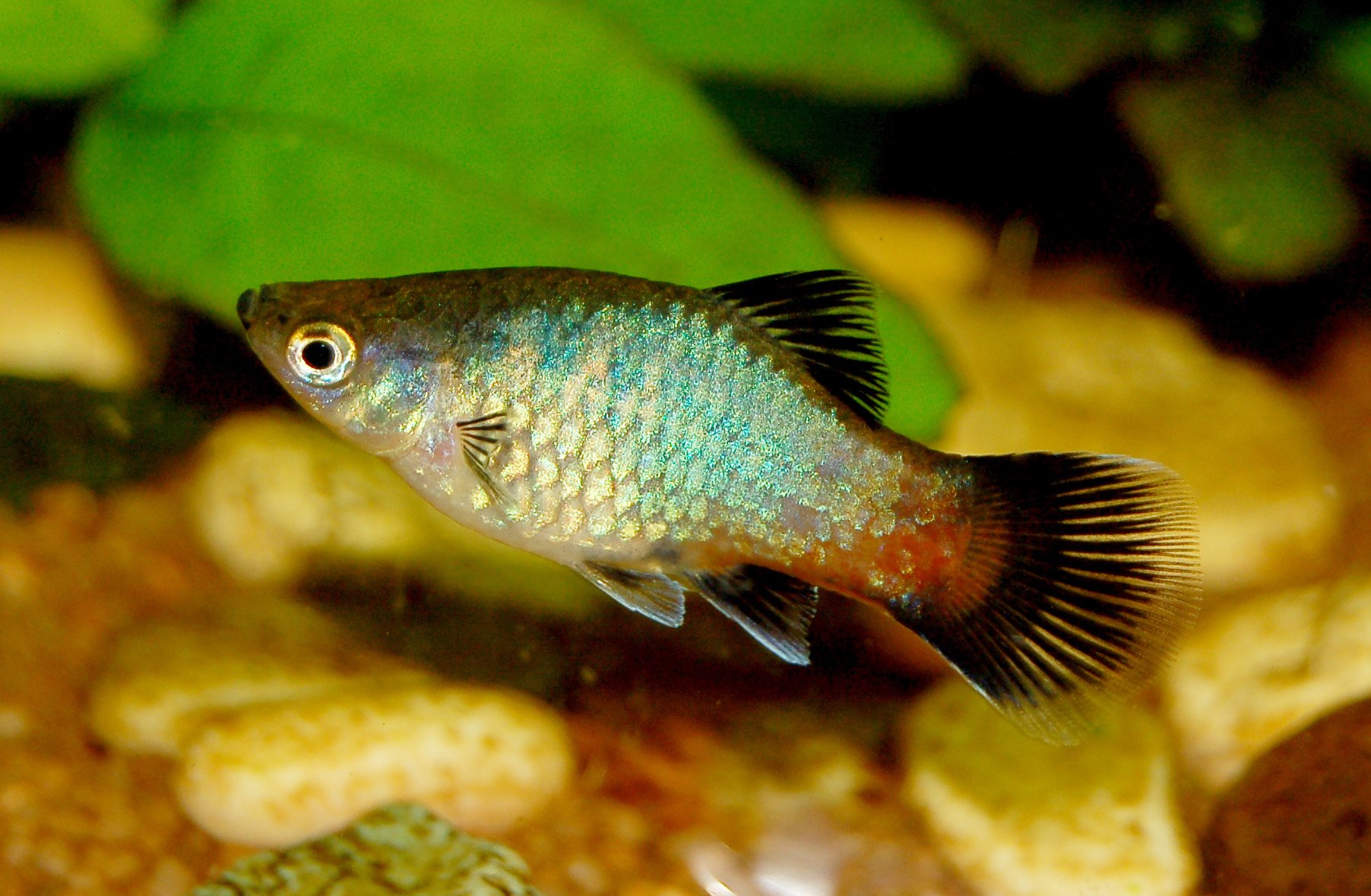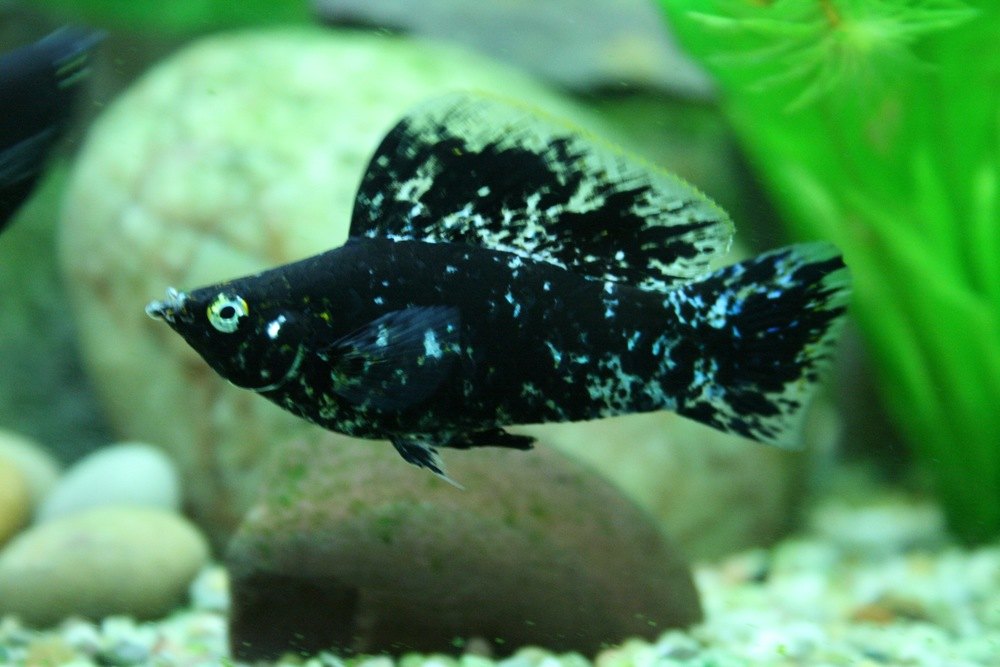If you are looking to populate an aquarium or liven up your living space, it’s more than likely that you have considered getting a Molly fish.
As a species, they’re very prone to hybridization, so you may have glanced at them in a pet store without even realizing it.
There are three different species of Molly fish that can be kept in an aquarium: short-finned, sailfin, and Mexican sailfin Mollies.

The Mexican variety is rarer than their cousins, making them a specialty for fish-lovers. They are also more difficult to breed and care for in captivity, though they do thrive in outdoor ponds.
Compared to the Mexican sailfin Mollies, the short-finned and sailfin varieties are prolific breeders.
Beyond the three taxonomically labeled species, there are hundreds of hybrid Mollies available on the market that you could end up taking home.
Regardless of DNA specification, though, populating an aquarium with Molly fish requires deep consideration of the care necessary to maintain their optimum health. Luckily, Mollies, when compared to their other fishy brethren, are fairly low maintenance.
Let’s take a look at some of the facts, and you can decide whether or not a molly is the right kind of fish for you.
Contents
Molly Fish Personality & Appearance
The three breeds of mollies all vary slightly from one another, though some of their aspects such as habitat and temperament remain consistent.
The following list includes basic descriptions of your average short-finned, sailfin, and Mexican sailfin molly, though hybrids should retain many of these traits as well:
- Average Size:
Short-finned molly: 3-4 inches.
Sailfin molly: 4-6 inches.
Mexican sailfin molly: 4-6 inches.
- Life Span: 3–5 years.
- Habitat: Brackish and fresh water.
Wild mollies prefer to live in tropical water and can be found in streams and marshes from Texas to North Carolina to Central America.

Price
Molly fish are usually sold at a very reasonable price making it a great fish for beginners or for those who are on a budget.
The most common Mollies can be purchased for around $2 to $3 while premium and rare fish can cost between $5 and $8.
Personality
Mollies have a peaceful and pretty laid back demeanour.
Males and females can live together without one or the other getting aggressive, but do take care! Mollies breed like no one’s business.
Breeding Mollies
Mollies are a peaceful breed of fish, meaning that you can keep males and females in the same tank without having to fear violent confrontations between the two.
However, short-finned and sailfin Mollies are quick to breed. If you haven’t planned for a number of smaller Mollies to be living in your tank, you could be in for quite the surprise. If you want to breed your Mollies, however, this tendency towards reproduction is hardly a bad thing.
In considering the population of your tank, you’re going to want to balance the ratio of male Mollies to female Mollies. The ratio should come in somewhere around three males to every one female.
Because of their drive to breed, male Mollies need several females to keep their attention. If only exposed to one or two other Mollies in the tank, it’s possible for a male Molly to become over-stressed, damaging his health and the atmosphere of the tank.

Of course, populating a tank as such means that there’s likely to be an influx of newborn fish. Monitor the population of your tank, and don’t hesitate to move part of the population to a new habitat if the tank is becoming overcrowded.
Mollies are live-bearing fish, meaning that they don’t lay eggs. Instead, like mammals, young Mollies are born live, ensuring that their gestation survival rate is much higher than that of egg-laying fish.
Despite not needing a place to lay their eggs, it would be good of you to provide your Mollies some foliage to hide in while they grow accustomed to your tank. Floating plants are ideal hiding spots for little ones to hide from adult Mollies or other breeds of fish you want to keep in your tank.
Health Concerns
The Molly’s affinity for salt water ensures that all breeds – from short-finned to the more exotic hybrids – maintain their health.
However, it’s not just the salt that works in the Molly’s favour; almost all Molly habitats are full of hard water packed with helpful minerals.
When housing Mollies in an aquarium, you’ll want to keep an eye on the mineral content of your water. If things aren’t as they should be, your Mollies could fall victim to a number of diseases.
The most notable to consider is Molly Disease, otherwise known as Shimmies, though Mollies can fall prey to a number of freshwater fish diseases.
Molly Disease is less of an actual illness and more a direct result of a Molly living in poorly cared-for habitats. In keeping an eye out for Molly Disease, you’ll want to watch your fish for lethargy, glazed-over eyes, or unusually aggressive behaviour.
Additionally, watch for an unusual amount of shimmying in your fish – thus the disease’s other name, the Shimmies. The best way to treat Molly Disease is to clean your Mollies’ tank. An improved environment typically leads to healthier behaviour without a problem.
In addition to Molly Disease, there are a number of freshwater fish diseases that could appear in your Molly, many of which come about due to the Molly living in an uncleanly or inappropriate tank.
If your Molly begins to act differently than normal, consider quarantining the fish and monitoring its behaviour in the cleaner water.
If your molly’s behaviour doesn’t normalize, you may want to consult this list to see what may be ailing your fish.
Molly Fish Care
As mentioned earlier, mollies are reasonably easy to take care of. When purchasing a tank, however, do consider the species you’re looking to host – different Mollies grow to different sizes.
A sailfin, for example, will likely need more room as it grows than a short-fin. A molly’s preferred habitat can vary slightly from the facts listed above, as well.
Hybrids especially may need care that differs just a bit from a standard short-fin or sailfin.

Tank Requirements
For short-fins, sailfins, and hybrids, you’ll need a tank that holds – at a minimum – 20 gallons of water. Fully grown sailfins are more likely to thrive in a tank that holds at least 29 gallons.
A tall tank will be more enriching for your Molly as well, but it’s not necessary for you to have one – a wide tank can still provide your molly with an engaging home.
If you want to wait before purchasing a larger tank, you can. All Mollies can be raised in the average 10-gallon tank before they start to grow.
Moving your fish, however, as they get larger could be an unnecessarily stressful experience for both you and your fish. The change in environment could negatively impact your molly’s health.
Water requirements
If you don’t know the details of the water your molly has grown accustom to, start off by filling your tank with fresh water.
If you do know the details, however, try to match the water in your tank to what the fish is used to; abrupt fluctuations in environment could threaten your molly’s health.
Keep the water between 70 and 82 degrees Fahrenheit, with a pH between 7.5 and 8.5.
Molly Tank Set-Up
In terms of filters, do your best to buy a filter that keeps your tank especially clean. Mollies don’t make an excessive amount of mess, but they thrive and are less likely to grow sick when their tanks are as well-filtered as possible.
Balancing this filtering and the growth of beneficial bacteria is admittedly a trick. Consider buying a tank off of a friend or a previous molly caretaker; these tanks will have been broken in and can help establish that initial balance.
Also take care to fill your tank with enrichment for your molly. Miniature coral reefs, bubblers, and curiosities are available almost everywhere mollies are sold, and ensuring that your fish has a comfortable environment to explore will make life easier and more enjoyable for the both of you.
Here’s a video showing a planted aquarium set-up for Molly fish.
Molly Fish Food
When not in captivity, mollies have a varied diet of algae and small, accessible invertebrates. In keeping with this omnivore diet, you’ll want to purchase a variety of high quality fish flakes and freeze dried food to feed to your new friend.
You can also look into purchasing vegetables that will be cut into fish-sized pieces for your Molly to enjoy. This species’ taste seems to vary, but work with smaller vegetables like peas and experiment to see what your molly likes best.
You can also consider buying live food for your Molly. This will offer up not only nutritional value but enrichment, as your Molly can engage in pseudo-hunting in order to earn themselves a meal.
Consider purchasing brine shrimp, egg whites, or bloodworms and mix them in with some of the aforementioned vegetable matter. Your Molly will be all the happier for this variety.

Keeping Molly Fish
Mollies are some of the easiest fish to care for and can make ideal residents in your home aquarium.
When bringing any species of Molly into your aquarium, though, you’ll want to consider the kind of space and care the fish will need.
The different breeds of Mollies can require differently sized tanks and diverse diets – not to mention a fair amount of enrichment.
You’ll want to carefully consider the gender of your Mollies, as well; if you’re not interested in breeding, you may want to stick to a tank full of either only-male or only-female Mollies.
Perhaps the most appealing, Mollies aren’t high maintenance fish. If you’re starting out with a salt water aquarium for the first time and don’t want to risk much rarer species as you get the hang of things, Mollies offer a stress-free proving ground to get your bearings.
Not to mention – they’re super pretty!
Do you own any Molly fish?

